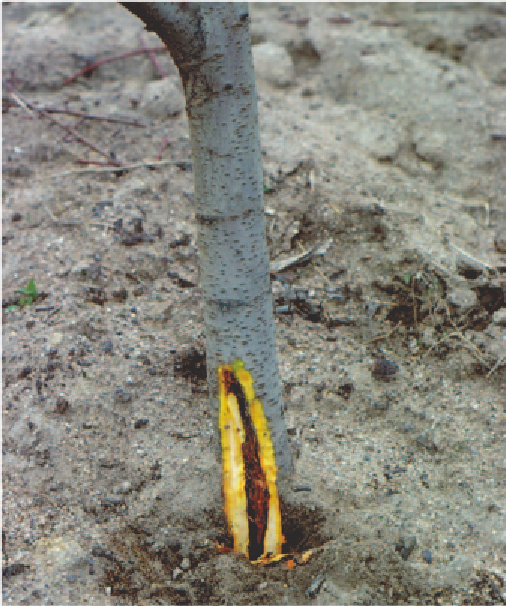Agriculture Reference
In-Depth Information
Cover pruning wounds with dressing quickly - at least
on the same day. More spores are released at night, and
unprotected wounds will be colonised quickly. Late
applications of wound dressing may make the situation
worse, trapping the fungus in the wound and sealing
the area off from other benefi cial organisms that might
outgrow or kill the fungus.
•
Importance
Phytophthora root and collar rots can be a problem in all
stone fruit production areas, particularly in areas prone
to waterlogging.
NEMATODES
Apply a commercial wound dressing formulation
containing cyproconazole and iodocarb.
•
ROOT-KNOT NEMATODE
(
MELOIDOGYNE
SPP.) AND THE ROOT-
LESION NEMATODE (
PRATYLENCHUS
PENETRANS
)
■
In problem-prone areas, remove alternative hosts, especially
willows and poplars, because they are particularly
susceptible and are an important source of inoculum.
•
PHYTOPHTHORA TRUNK, COLLAR
AND ROOT ROTS
Refer to the chapter on Common diseases of perennial fruit
crops.
■
Symptoms
Root-knot nematodes produce galls or swellings on the
roots, and root-lesion nematodes cause premature death
of fine roots. Infected trees lack vigour, become stunted
and occasionally infestation will be severe enough to kill
the tree.
Cause
The oomycetes
Phytophthora cactorum, Phytophthora
cambivora
and
Phytophthora cinnamomi.
Although caused
by three different species, the symptoms and treatment of
this disease is identical in Australian stone fruit orchards.
Source of infection and spread
The root-lesion nematode has a wide host range and is best
suited to sandy soils low in organic matter.
When the orchard trees are removed, high numbers of
nematodes remain in the roots or in the soil. In weed-free
fallow soils, nematode numbers tend to decline with time,
whereas they will increase if old tree roots, weeds or host
crops are present.
Roots of nursery trees may be infested with nematodes
from the rootstock beds or nursery soils.
Nematodes are mobile and can move short distances (a few
metres per year) while migrating to feed. Spread over long
distances occurs mainly through transport of soil on
cultivation implements and farm machinery.
Refer to the chapter on Common diseases of perennial fruit
crops.
Importance
Nematodes can cause relatively severe problems in the
Swan Hill, Granite Belt and Riverlands production areas.
Nematodes reduce growth, and can predispose trees to
attack by
Phytophthora
spp.
Management
•
Ensure that irrigation and fertiliser management are
adequate in established orchards, and maintain a thick
layer of carbon-based mulch under trees.
Fig 17.26 Vascular discolouration beneath a trunk canker on a peach
tree caused by
Phytophthora cinnamomi
.












